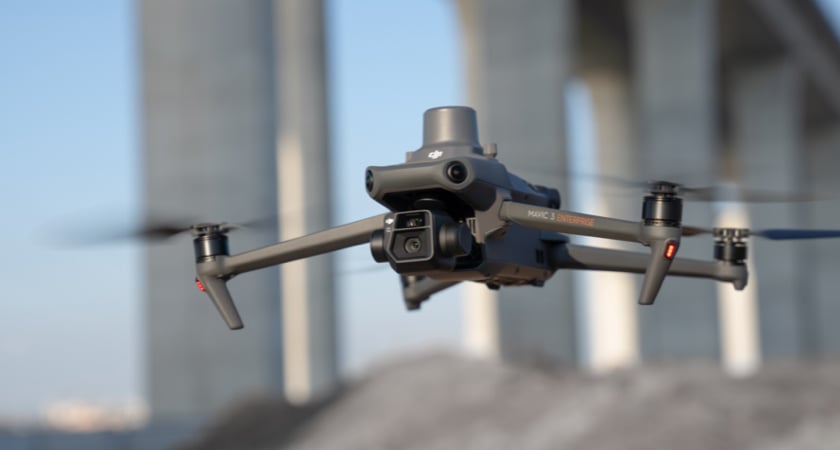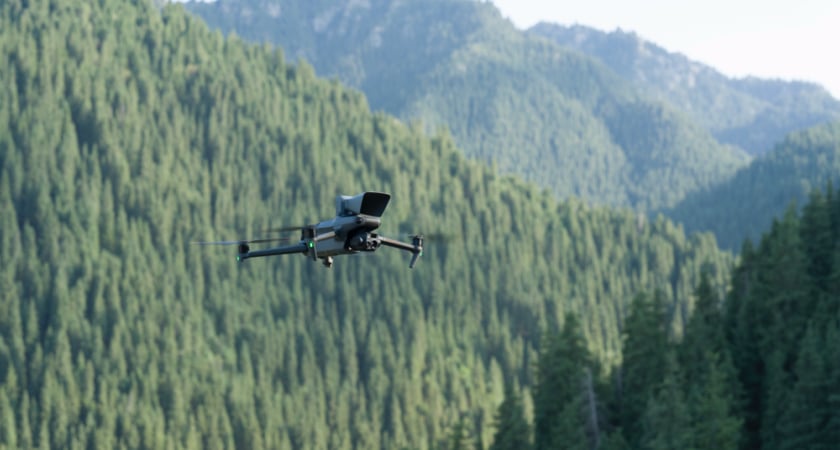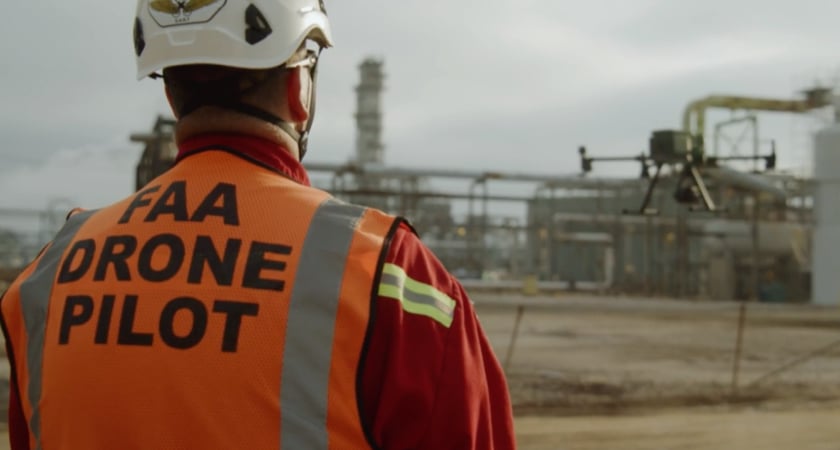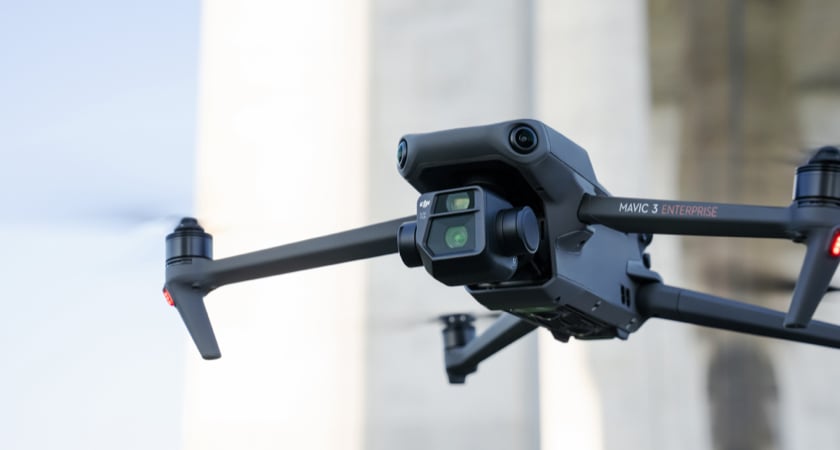Did you know you can make an entire career out of piloting drones — and earn up to a six-figure salary doing it?
Here, we’ll talk about the many ways you can earn money by being a professional drone pilot and the benefits drones can offer to particular industries. We’ll also tell you how you can get started in this budding and lucrative industry.
How to make money with a drone business
Drones are making waves across industries, making work faster, smarter, and safer.
A primary way to make money flying drones is as a drone photographer providing aerial photography and videography. Drone photography services are estimated to be worth $617.6 million in 2023, and are expected to climb to nearly $3.5 billion by 2033.
Surveys, inspections, and other opportunities are some of the most in-demand tasks for drone pilots. Whether it’s taking photos for real estate, agriculture, or weddings, drone footage is in high demand — and with that demand comes an equal need for professional drone pilots.
Aerial surveying and mapping is already a big industry, but it’s rapidly growing. The estimated worth of this field for 2023 is $617.6 million, and is expected to climb to nearly $3.5 billion by 2033.

What are the top drone career opportunities?
There are many career possibilities when it comes to drones. If you do it as a side hustle, you can create content for:
- Stock images (for sites such as Getty and Shutterstock). While selling stock photography might not sound particularly glorious in the drone business, keep in mind that this type of media is often used in movies and TV shows, making it potentially very profitable.
- YouTube channels. Sponsorships and advertising can make YouTube channels lucrative if they have a big enough audience. If you can get companies to use your material in their own media, this will bring even more traffic to your page.
- Weddings and other events.
However, you can also be employed as a drone pilot. Companies may hire you for:
- Agriculture
- Construction
- Surveying & mapping
- Infrastructure inspection
- Mining
- Forestry
- Real estate photography
Are you already a licensed professional pilot in the drone industry? Consider seeking out opportunities to teach others how to pilot drones safely. Given that the demand for drone pilots is increasing, so is the need for instructors.

Drones in agriculture
Agriculture used to involve manually going out into the fields and surveying crops from eye level. This was a painstaking and laborious process — and no matter how good you were at it, you could only get so much information without an aerial view.
That’s not the case if you have a drone to survey your fields from above. A drone job in agriculture is especially noteworthy for how technical it is.
With aerial photography, you can detect issues affecting crop growth, spot weeds, and check on growth progress. With specialized drones, such as the Mavic 3 Multispectral, it’s possible to measure how much sunlight crops are getting, and if there are sufficient nutrients for them to grow. This information is used by farmers to make decisions about how to treat their crops, such as by showing where fertilizer or pesticides need to go. This reduces operation costs, improves crop quality, and increases yield rate.

Spraying drones can even be programmed to deploy materials directly onto a farm. Some of those materials can be:
- Desiccants
- Seeds
- Pesticide
- Fertilize
- Herbicide
- Fungicide
A drone can do more than merely spray these onto crops — these machines can do so with precision and accuracy. Before, if you were applying these seeds, fertilizers, and chemicals yourself, there was a risk of applying too little or too much. Too little and the results would be suboptimal, potentially leaving crops open to insects, fungi, weeds, or other pests that can decrease the yield rate. On the other hand, too much can be just as damaging, with large amounts of waste and decreased crop quality. With drones, everything is measured and even, allowing you to spray just the right amount in just the right concentration. This is referred to as “smart spraying.”
Drones for surveying & mapping
Drones have revolutionized the surveying and mapping industry with their ability to capture data from above. A drone survey is simply a survey conducted from overhead using a drone, and it provides critical information that enables informed decision-making ranging from construction site planning to design and upkeep of infrastructure. Drones are superior to traditional surveying methods because they can rapidly acquire data from vantage points inaccessible to humans, eliminate the need for human operators to physically access hazardous or difficult-to-reach locations, and capture comparable data in dramatically shorter timeframes.

Drone surveying can produce a variety of deliverables depending on your choice of data sensors and surveying software:
- 2D orthomosaic maps
- 3D orthomosaic maps
- 3D models
- Thermal surveys
- LiDAR
- Multispectral maps
Drone solutions can produce surveys with different degrees of accuracy, and for high-precision applications, drones equipped with real-time kinematics (RTK) and post-processing kinematics (PPK) capabilities can achieve survey-level accuracy.
Drones in construction
In construction and project management, drone surveying can provide critical data that goes hand in hand with Building Information Modeling (BIM), which can reduce construction error, omission, and re-work. BIM is a digital planning technology that allows contractors to view the progress of their projects, and drones are the perfect tool to repeatedly collect accurate data for this system.

Drones are used across construction sites in many ways:
- Real-time data
- Building Information Modeling (BIM)
- Digital planning technology
- Project progress monitoring
- 3D point clouds
- Accurate digital models
- Stockpile volume measurements
- Aerial inspections
Drones are beneficial to contractors before, during, and after a job, providing an efficient and safe way to survey job sites and keep stakeholders updated on the current state of a project.
Piloting drones for first responders
First responders use drone photography in disaster relief and search-and-rescue missions when they’re trying to produce 3D maps, search for victims and assess damage. A drone with a thermal camera can help you see people clearly even in fog, foliage, dust, or smoke. This makes it far easier for first responders to locate individuals even in conditions in which the human eye couldn’t. Moreover, thermal imaging can see much greater distances than other low-light camera technologies such as night vision.

A first responder drone can also:
- Create before/after maps of an area impacted by a disaster.
- Take photos and videos for news coverage and communications.
- Assist firefighters in locating hot spots.
Check out if there are any local units that could utilize a good drone pilot. The increased demand for this type of drone pilot job means if you can do the work, there are plenty of first responders who would be happy to have you.
What drone training and certifications do you need?
All professional drone pilots require Federal Aviation Administration (FAA) certification to obtain a remote pilot certificate. In the U.S., you need to be at least 16 years of age before you can apply for one. The cost to take this certification is relatively low, typically around $150. It’s possible to take it either online or in person.
Specifically, you’re looking for training in unmanned aerial systems (UAS). Once you’ve passed the training, you’re a certified drone pilot.

How do you become a drone pilot?
While getting started is not particularly expensive, you’ll need a minimum amount of equipment to start making money with a drone — and you’ll want more than the drone itself. Before you begin, you should consider obtaining:
- Videography filters
- Software to edit footage
- The drone itself
- Extra batteries
- An FAA license
There’s a typical series of steps you can take if you want to become a drone pilot, according to Pilot Institute:
Practice with something relatively inexpensive first. You could immediately splurge well over $1,000 on a drone and try to get right into it, but considering how likely it is you’ll be crashing drones the first few times you experiment with them, that’s probably not the best idea. Instead, invest in something inexpensive — many beginner drones cost under $100 — and take advantage of drones that have “beginner modes” that throttle how fast they can go. Beginner drones also commonly utilize a “headless mode” which orients the drone to the position of the remote: Tilt the remote forward, and your drone will tilt forward; tilt it backwards and your drone will follow suit. This can help get you used to piloting a drone before you’re ready to do so with the more “professional” methods drone pilots use to control their equipment.
Register your drone with the FAA. All flying drones over 0.55 pounds need to be registered with the FAA, even if you’re only using them for fun. While many drones don’t reach this threshold, they typically don’t have cameras, since the latter adds a significant amount of weight. Thankfully, registering your drone is a relatively straightforward process that you can do online. Just punch in a few details about you and your drone, pay the $5 fee, and then apply the registration number they’ll give you to it. You don’t have to print out a label — a permanent marker is sufficient. All that matters is that the number is clearly visible on your drone for identification purposes.
Learn the ins and outs of both your drone and the regulations involved. This is where a training course can be very useful. You’ve probably heard the terms “yaw,” “pitch” and “roll” in aircraft lingo before, but you’ll need to be extra familiar with them as they apply to your drone and what you can do with it. You’ll want to become knowledgeable about how drones fly, which includes how your propellers generate lift, the atmospheric conditions that can affect drone flight, and what your drone’s sensors and controllers do. Failure to get all of this down can lead to crashes, injury to yourself or others, unsafe flying, and the potential destruction of your drone.
Your drone is an aircraft, and just like how commercial jet pilots do extensive pre-flight checks, you too need to learn how to do them with your drone. You should be able to quickly recognize when conditions are either safe or unsafe for drone flight. Learning the regulations is also key to preventing collisions with manned aircraft. For example, you’ll never want to pilot your drone near an airport or in controlled airspace.
You may be wondering how you’re supposed to know what is and isn’t controlled airspace. Don’t worry, there’s an app for that — and it can be installed right on your smartphone for easy reference.
Take the test. Once you feel you have the basics down, you can take the Part 107 remote pilot certification test. You should by no means take this lightly, as this test certifies you as not just a drone pilot, but an airman certified by the FAA. This is a 60-item multiple-choice test that will test your knowledge of all things related to safe drone flying. Getting 70% or more correct is considered a passing grade.
When you pass, you’ll need to wait a few weeks to a few months before the Transportation Security Administration (TSA) can run a complete background check on you. Once this is over, you’ll get a temporary certificate via email, with a physical copy being mailed to you. Your certificate is good for 24 months before you need to take a recurring exam to prove you’ve retained the knowledge you learned while studying for the certification.
Become a responsible commercial drone pilot. Once you’re certified to work as a drone pilot, you’ll need to continue to obey not just federal laws regarding drones, but also local laws that may be in place. The latter can be fairly tricky, as there’s no fixed resource for local laws, and you’ll be required to do your own research. You’ll also have to properly document flights and accidents that occur.
So you’re a certified drone pilot — now what?
Piloting a drone is one thing, but what you’re ultimately doing with it is creating a product. If you’re going for photographs and videos, raw footage isn’t going to earn you very much. If you want a shot at earning top dollar, you’ll need to become an expert in editing. This means mastering the computer software necessary to create outstanding, professional-quality media.
If you’re looking to deliver precise maps or 3D models of property or infrastructure, it’s necessary to become familiar with modeling software, such as DJI Terra.
There are lots of courses available online, and even some university degrees, that can get you started. However, even the most extensive training can’t make up for a lack of experience.
Consider dedicating some time to editing for free, either by working on your own personal projects or creating them for others. Photo and video editing is a career unto itself, so don’t expect to be a pro right away. However, if you want to sell quality media to clients, you’ll need at least be competent enough to create something worth selling.
While something like Apple iMovie or Google Photos are good starting points, you’ll eventually want to move on to more advanced software such as those made by Adobe.

What drones are best for individual owners?
Key to any drone photography or videography is the quality of the camera: The better your media looks, the more it’ll be worth. This means that certain drones are better than others if you want to be a professional drone operator.
First things first, you’ll need a drone that’s capable of serving your purposes. DJI is known as one of the leading manufacturers in the drone business for a reason, and the DJI Mavic 3E model is an excellent choice for those who want to create aerial footage. This features:
- A wide-angle 4/3 CMOS, 20MP sensor
- A mechanical shutter built to reduce motion blur during survey flights
- 0.7-second interval shooting for rapid mapping
- A 12 MP zoom camera in addition to 56x hybrid zoom
- About 45 minutes of flight time before needing a recharge

How much can I earn as a drone pilot?
Don’t expect to immediately start out your drone-flying career earning a lot of money. Beginner (less than one year’s experience) pilots make an average of $20 per hour, depending on their employer. If you stick with it and earn more experience, the average increases to about $27 per hour for 5-9 years of experience, and $36 if you have 10 or more years of experience, according to Payscale.
While the average annual salary for a drone pilot is around $50,000, that number varies depending on what type of drone work you do — as well as where you do it. For example, a commercial drone pilot will generally make more than a professional pilot.
The quality of the photographs you take also matters. Aerial photographs can be worth somewhere between $75 and $200 each. Like other forms of photography, this isn’t just a matter of the quality of your drone’s camera (though that certainly helps), but how skilled you are in taking photos. Videos, on the other hand, can be sold for a range between $500 to $1,000. If you dedicate yourself full-time to the task, you can reasonably expect to earn about $2,000 to $3,000 per week with a decent amount of experience. Factor in editing costs and you can make as much as $4,000 or more per project.
The sky’s the limit with drone career opportunities
Being a professional drone pilot is a potentially lucrative career — and one that can be exceptionally fun and rewarding. However, you can expect to spend dozens of hours studying before you’re certified to be a commercial drone pilot, and many more learning the ins and out of the industry you specialize in. The FAA takes drone piloting very seriously, and you’ll need to prove you can not only pilot a drone properly but that you can do so safely and responsibly every time you deploy. If you can do that, prepare yourself for one of the most exciting and versatile new career opportunities you can get today.
While you can get started with a beginner’s drone, it’s highly unlikely it will be sufficient for commercial use. If you’re looking for an enterprise drone that has the capabilities necessary to work as a commercial unit, check out DJI Enterprise for more information.


.png?width=300&name=L3kv%20(1).png)

.png?width=300&name=FH2%20update%20(1).png)
-1.png?width=300&name=HS%20-%20Featured%20Images%20(3)-1.png)